Heygate Regeneration
In July 2007, Southwark Council valued its 25 acre Heygate site at £150m1. The estate comprised 1,212 council homes of which 179 were leaseholders.
By Jan 2014, the council had spent £65m emptying the estate2 and a further £18m forward-funding its demolition3.
A 2012 appraisal study by global architects Gensler showed that the Heygate could be comprehensively refurbished for a total cost of £35m4.
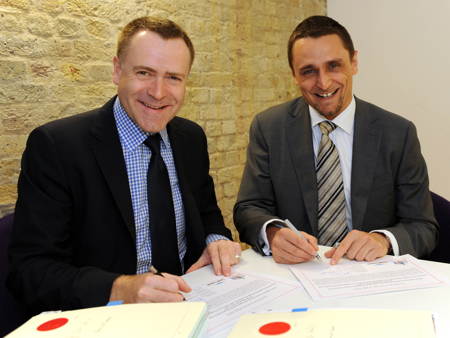 * Just 8 weeks after taking power from the Lib dems in 2010, Labour council leader Peter John signed an agreement to sell Lend Lease the 25 acre Heygate site for £50m5 and 1.4 acres of the old leisure centre site for £6.5m - significantly less than other E&C development sites which have exchanged hands on the open market:
* Just 8 weeks after taking power from the Lib dems in 2010, Labour council leader Peter John signed an agreement to sell Lend Lease the 25 acre Heygate site for £50m5 and 1.4 acres of the old leisure centre site for £6.5m - significantly less than other E&C development sites which have exchanged hands on the open market:
* The 1.5 acre Tribeca Square site was sold for £40m
* The 0.51 acre Eileen House site was sold for £38m
* The 3.5 acre Shopping Centre site was sold for £80m
Southwark argues that it will receive a share of the ‘overage’ profits when the Heygate development is completed in 2025, but this ‘overage’ arrangement only applies to profit surpluses after Lend Lease has pocketed a 20% “Priority Return” plus a 2.6% “Management Fee”6.
Furthermore, the amount of ‘overage’ (if any) is calculated by Lend Lease, which has a track record for accounting disputes over such agreements; in April 2012 it was fined $56m for overbilling authorities on a major public works contract in New York; in Dec 2012 it was sued by city authorities over its calculation of overage on a similar size regeneration scheme in Sydney; and in 2014 it was embroiled in a High Court battle with authorities over the terms of a development contract in Northern Australia.
In Feb 2013, Southwark’s Cabinet Member for Regeneration admitted in a local press article that “currently viability tests suggested there was unlikely to be any profit” from the Heygate deal. This was further backed up by council’s Project Director in Jan 2014, when he confirmed the possibility of “the council receiving little or nothing from the profit-share provision in the Regeneration Agreement.”7
In 2014, Lend Lease’s Head of International Operations Dan Labbad, who signed the deal with Southwark, claimed that his company had bought the Elephant and Castle at “the lowest point in the cycle.”
Southwark has argued that it will receive other in-kind planning contributions from Lend Lease amounting to a value of £51m. But these are standard s106 obligations that all developers must deliver to mitigate the impact of a given development. This figure includes a £13m local transport levy payment towards the £160m cost of increasing capacity at the Northern Line tube station. The remainder consists largely of benefits in kind: £24.9m is the estimated value of the new ‘public’ park to be provided by Lend Lease and £7.5m is the estimated value of new traffic infrastructure to be provided within Lend Lease’s development.8
Despite a policy requirement of 35%, the Regeneration Agreement signed by the council leader in 2010 stipulated that Lend Lease was to provide “A minimum of 25 per cent Affordable Housing”(pg 95), which is “to be divided equally between Social Rented Housing and Intermediate Affordable Housing”(page 1). However, when the planning application was submitted in Jan 2013, it provided 25% affordable housing but had largely substituted social rent for affordable rent of up to 80% market on the grounds of financially viability. As a result, of the 2,704 new homes on the Heygate, 198 will be intermediate ‘affordable rent’, 316 shared ownership and just 82 will be social rented. These 82 social rented homes fall well short of the 500 new homes promised to Heygate residents who had been offered the ‘right to return’ to the estate.9
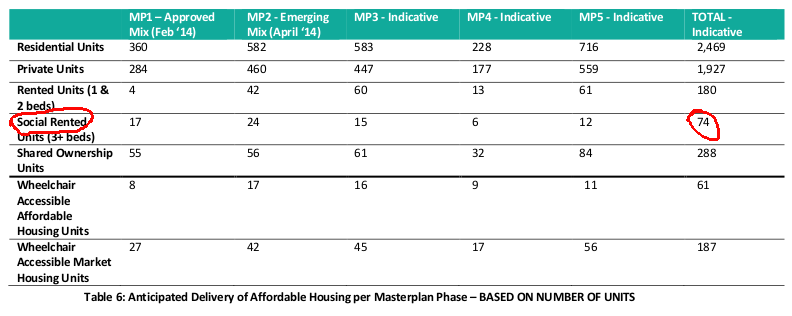
Cooking the books
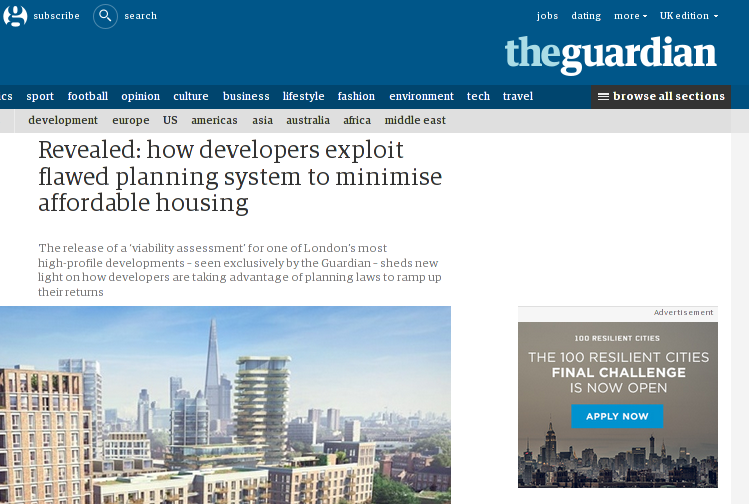 Guardian article Jun 2015In
2015, after a three year Tribunal battle by Lend Lease and Southwark to prevent
its disclosure, the 35% campaign succeeded in obtaining a copy of the viability
assessment submitted by Lend Lease to justify the reductions in its affordable
housing offer.
Guardian article Jun 2015In
2015, after a three year Tribunal battle by Lend Lease and Southwark to prevent
its disclosure, the 35% campaign succeeded in obtaining a copy of the viability
assessment submitted by Lend Lease to justify the reductions in its affordable
housing offer.
revealed.
The figures showed how Lend Lease had cooked the books to make the development look unviable and thereby negotiate down its affordable housing obligations.
Dining out
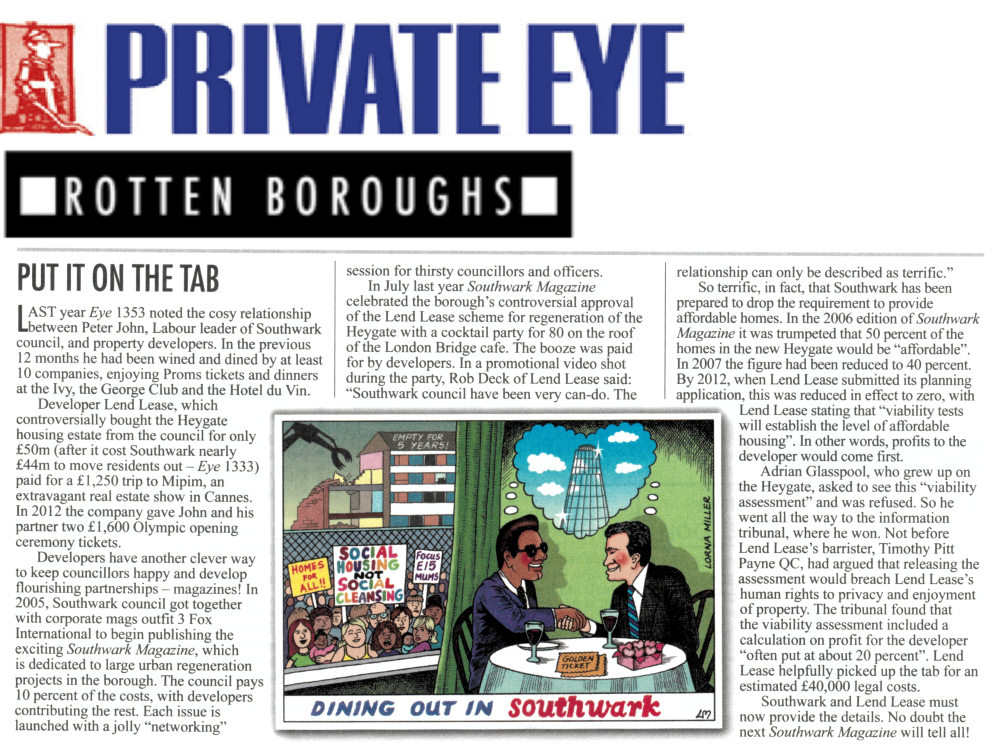 In July 2014, council leader Peter John came under criticism for dining with developers and accepting an all-expenses paid trip to international property fair MIPIM in Cannes, paid for by Lend Lease. (more details here)
In July 2014, council leader Peter John came under criticism for dining with developers and accepting an all-expenses paid trip to international property fair MIPIM in Cannes, paid for by Lend Lease. (more details here)
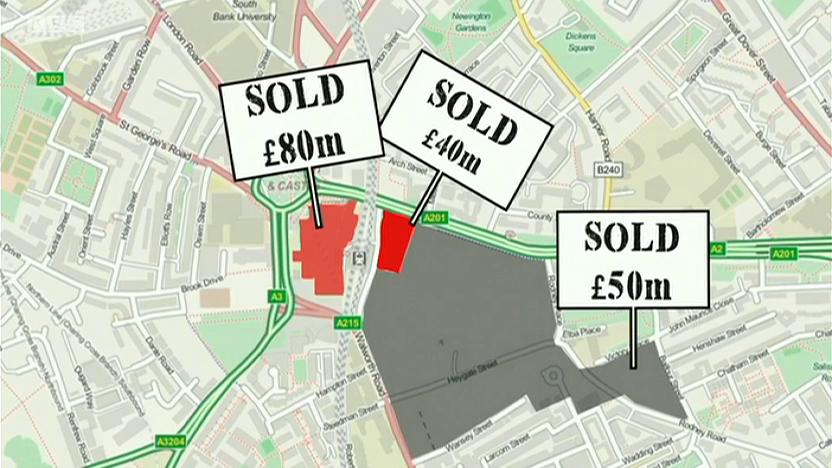
Postscript update
The Council has issued a press statement claiming that it will receive “hundreds of millions” from the Heygate profit overage deal. But when we asked for a copy of its most recent audit report showing how much overage it expects, it claimed it hadn’t received any audit reports - despite it being a requirement of the regeneration agreement. The topic was taken up on a BBC Politics show by local ctivist Peter Tatchell:
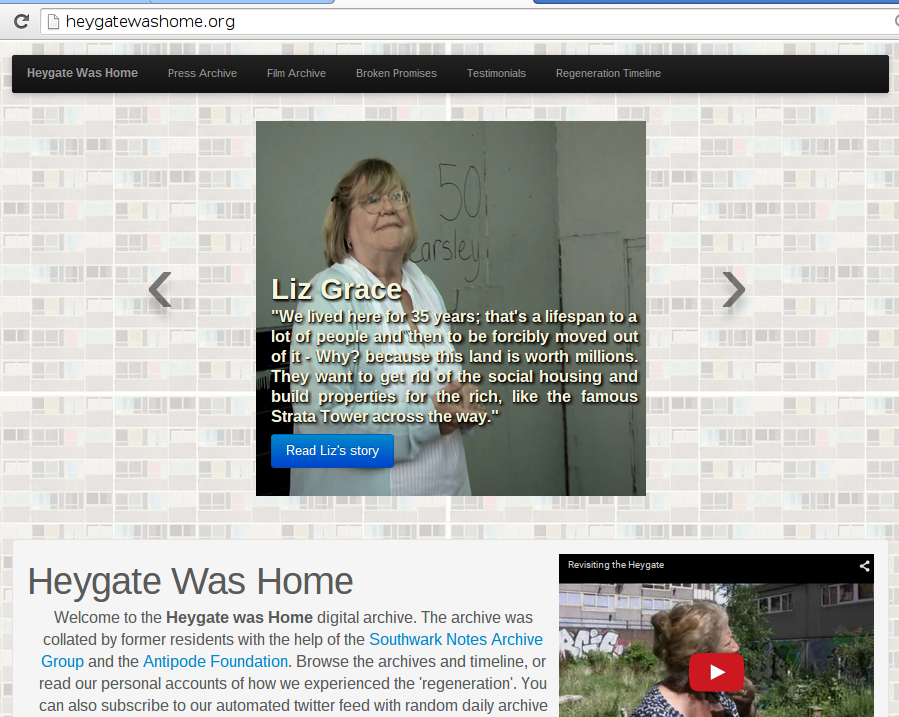 Heygate residents have set up a digital archive, charting the broken promises of regeneration and the impact it had on their community. This can be accessed at: http://heygatewashome.org
Footnotes
Heygate residents have set up a digital archive, charting the broken promises of regeneration and the impact it had on their community. This can be accessed at: http://heygatewashome.org
Footnotes
-
See paragraph 14 of this July 2007 Executive report ↩
-
See paragraph 50(ix) of the Heygate Tribunal evidence - “The Council’s costs as at January 2013 amounted to about £47.5 million in capital expenditure and just under £18 million in review costs managing the estate”.↩
-
See See para 76 of the Project Director’s evidence and this 2012 council report. ↩
-
See this 2012 cost appraisal study by global architects Gensler and construction consultancy Baqus.↩
-
See ‘Heygate Headlease Premium’ on page 6 and the ‘Rodney Road Headlease Premium’ on page 10 of the Regeneration Agreement.↩
-
See “Developer’s Priority Return” and “Development Management Fee” on pg 83 of the leaked Regeneration Agreement.↩
-
See para 86 of the Project Director’s Tribunal evidence↩
-
See section 2 of the S106 Draft Heads of Terms for details of all S106 planning contributions.↩
-
See page 59 of the original regeneration masterplan and the ‘Heygate Action Plan’ right-to-return documents.↩
